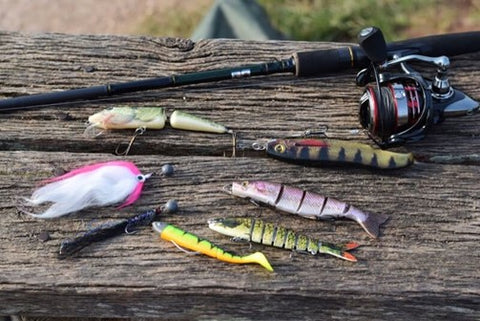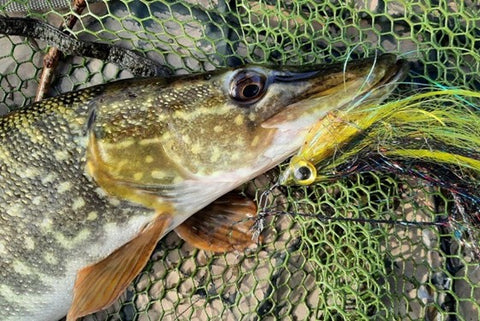Live session: Fly vs lure for pike!
Have you ever fished side by side with a friend to compare different approaches? It can be an interesting exercise to compare and contrast methods.
If we take fly and lure fishing, each has some distinct advantages over the other, especially where pike are concerned. While lures can be cast further and have more vibration, fly fishing for pike has its own distinct benefits.

Why this should be the case is down to several factors, not least of all the huge current popularity of lure fishing! Not only does a fly offer something very different, it also offers a much slower, subtler presentation for tricky days or fish that are not in attack mode.
The proof of the pike is in the catching, however, so this month we thought we would have a friendly fish-off between the two. Each of our anglers uses both methods, it’s fair to say. But for the sake of our day out, Ollie Jefferies chose to fish lures while Dom Garnett tried his favourite the fly approach. But who would prevail on a hard-fished Exeter Canal?
8:30 Dad duties have ruled out a crack of dawn raid for our duo, but conditions look reasonable. There’s a lovely mist on the water and a bit of breeze, while the water is reasonably clear with just a slight greenish tinge. Our anglers are hopeful anyway!

8:40 Straight into the action, Dom kicks off with a weighted silver tinsel fly from Turrall. The thinking is that this will get down fairly fast, allowing him to get down to mid-depth (and this canal is 12ft deep in the centre) in no time. A fast intermediate line will also help search these deep waters.

Meanwhile, Ollie starts off by throwing a jointed swimbait. The key with so many canals and drains is to get your lure or fly to the right level, often just above the weed where predators can see it.
Both our anglers are taking no chances with tackle, with 40lb braid in Ollie’s case and 30lb fluorocarbon leader for Dom, besides wire traces. This means no risk with a bigger pike, besides more lures and flies safely retrieved from bushes and snags!
9:00 With no takes forthcoming, it’s a case of keep moving and casting. The lads cover water fairly quickly yet methodically. Rather than throwing for the distant far bank at 30 odd metres, a better policy is often to cast diagonally along the near bank. Pike especially love the “shelf” on each side, where at about two rodlengths out, the depth plummets from three to four feet to double that.
9:30 Ringing the changes always makes sense when piking. When the going is slow, Dom often switches to a black fly. Not only does this show up brilliantly from below, it’s also something a bit different purely because it’s a colour very few other anglers use.

Ollie, meanwhile, is also mixing up his options. A “Real Eel” certainly looks the part- and this canal has always had plenty of eels in it that pike must surely eat? It’s also refreshingly different to the usual brightly coloured shads and jointed plugs the pike see so often. Over to you, pike.
10:20 Well, it’s taken well over an hour, but finally the first fish is spotted. After changing flies and casting along the margin, Dom sees a fish of 2-3 lbs snake along after the fly. Frustratingly, it just won’t bite! Dom tries switching to a smaller fly, but it seems this fish is just curious rather than ravenous.
10:35 It’s Ollie’s time to get some attention now. There is a sharp rap on his rod tip as he brings the lure across the near shelf. Unfortunately, it doesn’t stick! Damn it…
10:45 In the next few minutes, two more pike are spotted. It’s curious that the jacks seem to bunch up in late winter- perhaps they are gathering to spawn in the next few weeks? Regardless of the reason, they seem willing to have a look at a lure or fly but just won’t open wide.
Another fish then literally noses the fly but doesn’t find the hook. While Dom has not always been a fan of stinger hooks or tandem flies (below) for pike, an exception might need to be made for these picky predators.

11:15 With the sun now high and the cloud clearing, conditions are looking tough. For the next hour or so, we see very few signs of life. That said, this is common for a big, deep canal. Unlike a shallow drain or narrowboat canal, you will only very rarely see fish jumping clear when a pike attack takes place. This can make finding the fish harder! We do spot a couple of big fish in the margins as the light increases, but unfortunately they’re not pike- one is a ghost carp of 10lbs plus!
12:30 After a quick bite to eat, it’s time for a rethink. Our anglers head towards Lime Kilns, along with some different lures and flies. Ollie decides to try a few casts with a topwater lure, while Dom switches to one of Turrall’s large tandem flies in black. There are definite days here when the fish are reluctant and you have to annoy them into taking or try something completely different.
13:05 Oooh! So close. The black fly is followed by a slightly better fish, this time 5-6lbs. The tail fibres of the fly are virtually tickling the predator’s nose on this occasion, but he just won’t inhale. They definitely seem to be curious rather than hungry today- all we can do is keep trying.

Slower retrieves are often the way when pike aren’t in feeding mode- and it’s also interesting to see that more lure anglers are now trying furred and feathered artificials. In fact, one really neat way to fish a fly using a lure rod is simply to attach one to a Cheb weight, as above. This way, any fly can be turned into a jig!
13:40 Another curious aspect of the fishing today is where most fish are found. While the margins can be good this time of year, it’s slightly further out that most following fish are found today. Whether a couple of frostly nights have sent them into deeper water, who can tell? A good general rule is that you’ll find smaller jacks all year in any marginal cover, but the real net-fillers of 8lbs plus tend to come from down the “shelf” at least 2-4 rodlengths out.

14:10 Success at last! Just when things looked really bleak and it seemed a no score draw would be the final outcome, everything changes. Shortly after changing to one of the biggest home-tied flies in his box, Dom manages to tempt a fish. Predictably, it hits the fly down the shelf, 3-4 rodlengths out. Initially, it thumps wildly, before revealing itself as merely a small pike with a bad temper! Never mind, it’s a blank saver.
15:00 As our anglers pack up, it has been a tough old day on what can be a tough venue. At this time of year, the fish have certainly seen a lot of lures and baits thrown at them!
In the next few weeks, of course, it will also be time to give the pike a break. How long can you fish for pike in spring is a debate in itself! Once the water is warmer, not only does the weed grow with a vengeance, Dom won’t fish the canals for pike much later than mid April (and obviously on rivers you must stop mid-March) on as a general rule, simply because it isn’t fair on the pike.
On the whole, it has been a tricky season with covid restrictions, but a few better fish have shown for our anglers. One definite trend for Dom has been the value of digging out the fly rod on hard-fished venues! In fact, he’s had five pike in the last three fly fishing trips, compared to zero in four sessions on bait. Proof, if it were needed, that fly fishing is not just an eccentric bit of fun but often the best way to fish for pike!

Read more from our team…
Don’t forget to follow Turrall Flies on Facebook and keep an eye on the blog for further articles, news and more. In previous posts we’ve covered some great tactics for all kinds of flyfishing adventures, from static buzzer fishing for trout, through to tackling perch and chub on the fly in urban surroundings.






Leave a comment